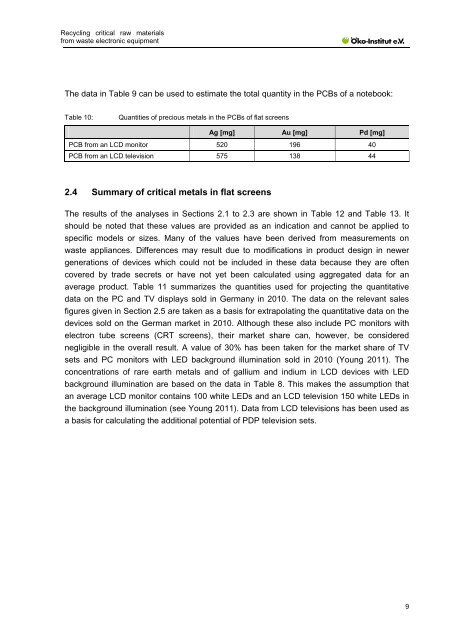Recycling critical raw materials from waste electronic equipment
Recycling critical raw materials from waste electronic equipment
Recycling critical raw materials from waste electronic equipment
Create successful ePaper yourself
Turn your PDF publications into a flip-book with our unique Google optimized e-Paper software.
<strong>Recycling</strong> <strong>critical</strong> <strong>raw</strong> <strong>materials</strong><br />
<strong>from</strong> <strong>waste</strong> <strong>electronic</strong> <strong>equipment</strong><br />
The data in Table 9 can be used to estimate the total quantity in the PCBs of a notebook:<br />
Table 10: Quantities of precious metals in the PCBs of flat screens<br />
Ag [mg] Au [mg] Pd [mg]<br />
PCB <strong>from</strong> an LCD monitor 520 196 40<br />
PCB <strong>from</strong> an LCD television 575 138 44<br />
2.4 Summary of <strong>critical</strong> metals in flat screens<br />
The results of the analyses in Sections 2.1 to 2.3 are shown in Table 12 and Table 13. It<br />
should be noted that these values are provided as an indication and cannot be applied to<br />
specific models or sizes. Many of the values have been derived <strong>from</strong> measurements on<br />
<strong>waste</strong> appliances. Differences may result due to modifications in product design in newer<br />
generations of devices which could not be included in these data because they are often<br />
covered by trade secrets or have not yet been calculated using aggregated data for an<br />
average product. Table 11 summarizes the quantities used for projecting the quantitative<br />
data on the PC and TV displays sold in Germany in 2010. The data on the relevant sales<br />
figures given in Section 2.5 are taken as a basis for extrapolating the quantitative data on the<br />
devices sold on the German market in 2010. Although these also include PC monitors with<br />
electron tube screens (CRT screens), their market share can, however, be considered<br />
negligible in the overall result. A value of 30% has been taken for the market share of TV<br />
sets and PC monitors with LED background illumination sold in 2010 (Young 2011). The<br />
concentrations of rare earth metals and of gallium and indium in LCD devices with LED<br />
background illumination are based on the data in Table 8. This makes the assumption that<br />
an average LCD monitor contains 100 white LEDs and an LCD television 150 white LEDs in<br />
the background illumination (see Young 2011). Data <strong>from</strong> LCD televisions has been used as<br />
a basis for calculating the additional potential of PDP television sets.<br />
9

















